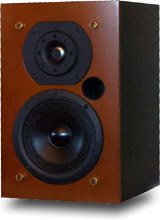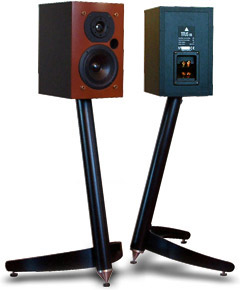Three corners as in three musketeers
 Triangle is France’s third-largest speaker manufacturer, right
behind JMlab and Cabasse. Triangle enjoys a massive dealer network of 300 in France alone.
It’s not too far off to call them a French Boston Acoustics or Polk Audio.
Triangle is France’s third-largest speaker manufacturer, right
behind JMlab and Cabasse. Triangle enjoys a massive dealer network of 300 in France alone.
It’s not too far off to call them a French Boston Acoustics or Polk Audio.
Triangle favors metal tweeters and fiber-oriented cellulose midrange/woofers with
triple-pleated surrounds. They engineer and manufacture all of their own drivers, and they
employ the same ones throughout their lines -- larger models have two, or sometimes even
three, woofers.
The Titus XS is the least expensive model in Triangle’s seven-model Ecran line.
Its slightly convex MDF front baffle is finished in either an attractive reddish-brown
sienna or metallic carbon black. The other sides are pebbled black vinyl veneer. VMAX Services, Triangle’s
Canadian and US importer, has already announced that the company will introduce a
real-wood-veneer option for the entire Ecran line later in the year. The XS designation is
given to those loudspeakers using Triangle's 1" titanium dome, which is also used in
the Ecran series topping out with the $1595 Antal XS. A variation on this tweeter also
appears in their top-tier Grand Angle lineup of speakers that cost as much as $4000 per
pair. This not only ensures a very recognizable "house sound," it means that a
budget shopper gets the full measure of the company’s know-how even with their
entry-level offerings.
The Titus XS is a front-ported 5.5" two-way with two pairs of metal five-way
binding posts. It’s a nominal 4-ohm load and is very efficient at 90dB. Despite its
relatively modest footprint (11.8" H x 7.9" W x 10.9"D), its bass extension
reportedly goes down to 60Hz (-3dB). The woofer does not have a conventional electrical
crossover -- its mechanical roll-off is carefully calculated to serve as a low-pass
filter. This makes for a minimal network (a single capacitor connected to the tweeter),
which makes the speaker a very easy load for the amplifier. The Titus XS retails for $495
per pair.
The Triangle sound
I connected the Triangles to the Cambridge Audio stack I reviewed last time, using
Cardas Audio’s affordable blue Crosslink cables, and set up the speakers on
Triangle's stylish Boomerang stands ($295 per pair). If you want to cut down the expense,
buy a more "pedestrian" but equally functional stand. Like all high-quality
monitors, the Titus XS must be raised off the floor to align the tweeter approximately at
the listener's ear level. Even though the front-firing ports make close wall or even
bookshelf placement an option, the Titus XS will perform best if it has breathing room.
The Titus XS is a highly sophisticated little ‘un. Like all Triangle speakers
I’ve heard, it has a very particular sonic flavor -- one of excitement and vitality.
This is partly due to a purposely contoured treble. The Titus XS is probably up a dB or
two around 12-14kHz. In a nearfield position, placed in a small room or partnered with hot
electronics, the Titus will have a tendency to sound bright and forward. In my good-sized
room, however, sitting 13’ away, what came across wasn’t brightness at all but
an invigorating sense of energy and liveliness. This conveyance of excitement is also a
function of the firm’s proprietary wideband midrange/woofer. It’s expressly
engineered for speed and dynamics over ultimate extension.
Accordingly, the bass from the Titus XS is extremely punchy, taut and fast, but not the
last word in depth. It goes low enough to fully replicate the upright bass on Charlie
Haden’s & Pat Metheny’s Beyond the Missouri Sky [Verve 314 537
130-2]. For more bass-heavy fare especially in larger rooms -- I’m thinking of
Mychael Danna’s "Gold Dust Bacchanalia" drum-and-synth track from the movie
soundtrack Kamasutra [TVT 8100-2] -- you might consider augmenting the Titus XS
with an equally tight and well-damped subwoofer. I can point enthusiastically to the
over-achieving Hsu Research VTF-2. At $500, it produces an honest 25Hz at -1dB and is the
antithesis of the one-note boom box that’s quite common at this price point. Look for
an upcoming review of it.
Vicente Amigo's Vivencias Imaginadas [Sony CDZ-81782] became a showcase for the
Titus XS's superior transient speed. Amigo is often considered Paco de Lucia's
flamenco-guitar successor. The track "Mensaje," in particular, features plenty
of the typical lightning-fast chord strumming, called rasgueados, interlaced with
equally flashy arpeggios, all punctuated by precise foot stomps, hand claps and the
machine-gun tattoo of the cajon drum box. If a speaker's transient attack is lacking, this
music loses its highly percussive, blistering qualities. The Titus XS acquitted itself very
well, re-creating the vibrant, exciting Gypsy fandangos to perfection, preserving the
fierceness of the guitar's attack and the explosive foot stomps. It also allowed very
clear differentiation between the dancers' footwork and the similar-sounding cajon,
and it conveyed the hand claps as real and originating from multiple performers.
One of my favorite female vocal performances is Carmen Lundy's "'Round
Midnight" on Self Portrait [JVCXR-0005-2], an XRCD remastering. This is the
epitome of the mature jazz ballad. Lundy uses her rich, creamy alto to suggest a wide
range of emotion with subtle inflection, adapting her intensity as the interpretation
demands. On a good system, the sense of presence and her command over her instrument will
become palpable in your living room. The high-resolution Titus XS passed this test with
flying colors and reproduced the oboe and massed strings with correct timbre -- a big job
for an affordable loudspeaker.
 For a serious get-down track, I grabbed The Best of
Fourplay [Warner Bros. CD 46661] and cued up "Higher Ground," featuring the
vocal group Take Six. The solo and harmony vocals sounded spot-on and beautifully layered.
The bass lines were well damped, articulate and sinewy taut, but, not surprisingly, lacked
a small degree of impact and extension. This is where a superior subwoofer can make all
the difference. If you are thinking subs, I strongly advise not filtering the
signal to the Titus XS. Simply feed the subwoofer via its line-level or speaker-level
inputs and set its low-pass filter to about 50Hz. The Titus XS is a very sophisticated
loudspeaker and will clearly highlight the difference between a straight signal from your
amp and one that has first passed through a filter network.
For a serious get-down track, I grabbed The Best of
Fourplay [Warner Bros. CD 46661] and cued up "Higher Ground," featuring the
vocal group Take Six. The solo and harmony vocals sounded spot-on and beautifully layered.
The bass lines were well damped, articulate and sinewy taut, but, not surprisingly, lacked
a small degree of impact and extension. This is where a superior subwoofer can make all
the difference. If you are thinking subs, I strongly advise not filtering the
signal to the Titus XS. Simply feed the subwoofer via its line-level or speaker-level
inputs and set its low-pass filter to about 50Hz. The Titus XS is a very sophisticated
loudspeaker and will clearly highlight the difference between a straight signal from your
amp and one that has first passed through a filter network.
The Titus XS images like a demon and is transparent as all get-out. This is admittedly
often true of small monitors, but superior drivers and a minimalist crossover can
significantly enhance this trait. Indeed, the Titus XS sounds surprisingly like Triangle's
far more expensive loudspeakers and out-images some of them by a small margin -- although
it can't compete with the bottom-end extension of the models with multiple woofers.
However, by virtue of its high-frequency profile, the Titus XS elicits an unbelievable
amount of finely honed detail. This will please tube lovers in particular since they often
suffer from slightly rolled-off treble, excess warmth and a concomitant obscuring of
resolution.
Let’s compare the Polk RT35i from our last review with the Titus XS. I call the
RT35i "comfortably warm." It extends lower than the Titus XS and, by comparison,
sounds robust, burly and good-natured. The Titus XS, then, would be the witty,
cosmopolitan and sharp brainiac with a decided penchant for expensive threads. Who’d
you rather hang out with? There’s no easy answer. It all depends on your system, your
room, your listening habits and personal priorities. If you value refinement,
sophistication and a very "live" feel over greater output capabilities, deeper
bass response and a slightly more laid-back sound, the Titus XS is your poison. The Polk
RT35i becomes the contender if you answered those questions in the reverse.
But in June, I'm going to introduce you to the Axiom Millennia M3Ti, which, like the
Triangle and the Polk speakers, performs far above the expectations generated by its price
tag. Choosing the right speaker isn't going to be easy when you have choices like this!
Prices of equipment reviewed: